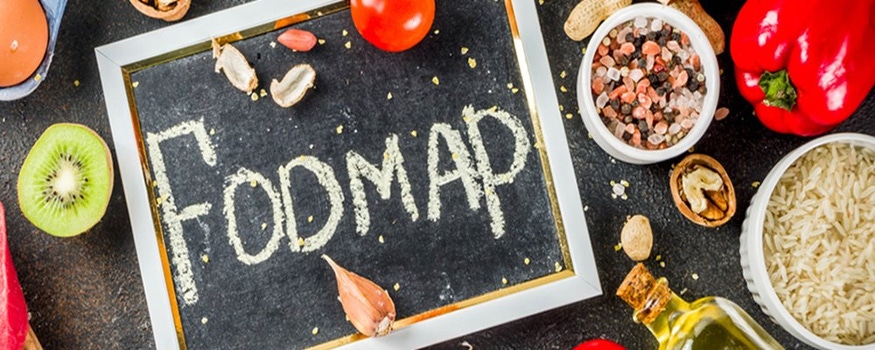
FODMAPs - Why certain foods can upset your gut
Gut health is gaining plenty of attention for its links to everything from our weight to mental health and even improved immunity.
Eating certain foods to improve gut health may also help some people to reduce or avoid common problems like bloating, abdominal pain, constipation and diarrhoea – tummy troubles that most of us are keen to avoid. One diet which is garnering attention in this area is the low FODMAP diet.
This is a scientifically tested diet developed by a team at Australia’s Monash University with the aim to help alleviate the symptoms of Irritable Bowel Syndrome (IBS).
Download our free nutrition fact sheets for expert dietitian advice on gut health and coeliac disease.
What is IBS?
Irritable Bowel Syndrome (or IBS) is characterised by reoccurring abdominal pain, cramping, bloating, wind, and/or altered bowel habits (ranging from diarrhoea to constipation) but with no other evidence of disease. It is thought to affect one in seven New Zealand adults.
What‘s a FODMAP?
FODMAP is an acronym of Fermentable Oligosaccharides, Disaccharides, Monosaccharides and Polyols - the scientific names that belong to a group of natural sugars that aren’t easily absorbed by your gut. As FODMAPs aren’t absorbed, your gut bacteria ferment these sugars, which for some people can lead to the unpleasant symptoms associated with IBS.
How does the diet work?
The low FODMAP diet doesn’t look the same for everyone. Different people will have different tolerance levels for FODMAPs, so it’s all about finding the right balance.
To do this, it’s recommended that you start the diet under the supervision of a dietitian or qualified healthcare professional who can help guide you through a strict low FODMAP diet for about 2-6 weeks. After this initial phase, foods that are high in FODMAPs can be gradually reintroduced to see how the body responds. This helps to determine tolerance levels before IBS symptoms appear.
In most cases, people are able to reintroduce many high FODMAP foods back into their diet, but may not be able to eat them as often or in the same quantity as they did before. A dietitian or healthcare professional will also be able to identify whether there are other dietary or lifestyle factors that may be triggering a person’s IBS symptoms such as fatty or spicy foods, caffeine, certain medications, and stress.
To summarise:
1. The initial phase of the diet is restrictive, so finding your own tolerance level is key to building a healthy, varied diet that doesn’t cause symptoms.
2. There are a lot of healthy foods that are high in FODMAPs and you don’t want to be missing out on them entirely, especially if you don’t have to.
3. Another good reason to start this diet under the care of a dietitian or health care professional is that foods which are high in FODMAPs also tend to be a good source of prebiotic fibre, which is the fibre that feeds our good bacteria in our gut. To find out more about the good and bad bacteria in your gut, read our Ultimate Guide to Gut Health article.
What foods are high in FODMAPs?
FODMAPs are found in a wide range of foods, however for most foods, there are low FODMAP alternatives. Here are some common foods that are high and low in FODMAPs:
| High FODMAP Foods | Low FODMAP Foods | |
| Vegetables | Asparagus, artichokes, cauliflower, onions, leek, garlic, beetroot, mushrooms, green peas | Bean sprouts, green beans, bok choy, broccoli, capsicum, carrot, celery, chives, corn, cucumber, eggplant, lettuce, spinach, squash, swedes, sweet potato/ kumara, potato, turnips, olives, parsnips, zucchini/ courgette, tomato |
| Fruits | Apples, apricots, pears, mango, watermelon, nectarines, peaches, plums, prunes and dried fruit | Banana, blueberries (limit ¼ cup per serve), grapefruit, grapes, kiwifruit, honeydew melon, passionfruit, papaw, rockmelon, strawberries, raspberries (limit 1/3 cup per serve) |
| Milk and Dairy | Cow’s milk, yoghurt, soft cheeses, cream, custard, ice-cream, soy milk made from soy bean | Plant-based milks e.g. almond milk, soy milk made from soy protein isolate, lactose-free milk, lactose-free yoghurt, hard cheese |
| Protein Sources | Legumes (baked beans, kidney beans, chickpeas, lentils etc). Some processed and marinated meats. Cashew and pistachio nuts. | Firm tofu, eggs and tempeh are also considered low FODMAP. Almonds (limit 10 per serve), macadamia nuts, peanuts, walnuts, pumpkin seeds, sunflower seeds. If eating meat, plain meat, poultry, seafood and fish |
| Grains | Wheat, rye, barley and foods made from these grains. Most breads, cereals, pasta, noodles and crackers | Gluten free bread, sour-dough spelt bread, oats, gluten free pasta, rice, quinoa, amaranth, millet, polenta, buckwheat |
| Miscellaneous | High fructose corn syrup, honey, sugar free confectionary and chewing gums. Foods containing inulin or chicory root | Dark chocolate, maple syrup, table sugar |
Therapeutic, not fad
The low FODMAP diet is what’s referred to as a therapeutic diet, which means that it is used in the treatment of a specific medical condition. It’s not one of the latest fad weight loss diets, it’s a treatment relieving the symptoms of IBS and improving quality of life.
In this way, it’s similar to a gluten-free diet for treating people with coeliac disease.
Where the two diets differ is that a low FODMAP diet will uncover an individual’s tolerance for the restricted foods, whereas someone with coeliac disease must avoid all foods containing gluten.
If you suffer from IBS symptoms and are interested in seeing how the low FODMAP diet might be able to help you, have a chat with your dietitian or health professional and find out more about the diet at https://www.monashfodmap.com/about-fodmap-and-ibs/.
Want more information?
Download our free nutrition fact sheets for expert dietitian advice on gut health and coeliac disease.

The latest nutrition advice, plus health and wellness tips delivered to your inbox monthly